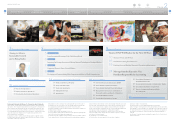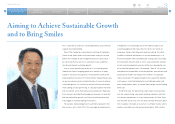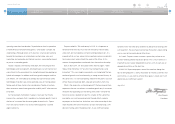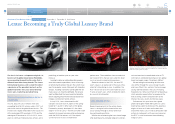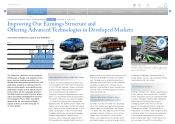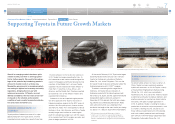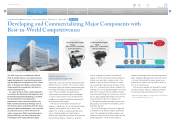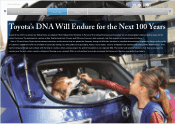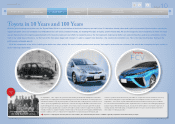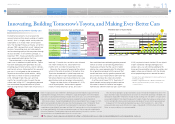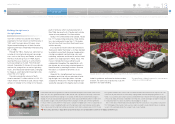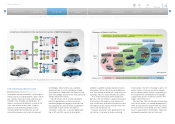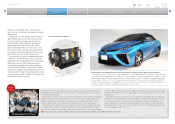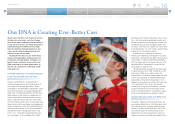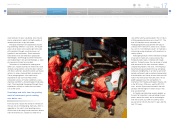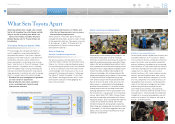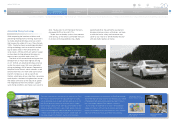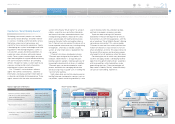Toyota 2014 Annual Report Download - page 12
Download and view the complete annual report
Please find page 12 of the 2014 Toyota annual report below. You can navigate through the pages in the report by either clicking on the pages listed below, or by using the keyword search tool below to find specific information within the annual report.
ANNUAL REPORT 2014
President’s MessagePresident’s Message
Overview of
Four Business Units
Overview of
Four Business Units
Special FeatureSpecial Feature
Review of OperationsReview of Operations
Consolidated Performance
Highlights
Consolidated Performance
Highlights
Management and
Corporate Information
Management and
Corporate Information
Investor InformationInvestor Information
Financial SectionFinancial Section
Page 12
NextPrev
ContentsSearchPrint
Further advances in key technologies
for hybrid technology
Hybrid technology can be applied to the develop-
ment of all sorts of environment-friendly vehicles
and can be found in a wide variety of powertrains.
Toyota has positioned hybrid technology as a
core environmental technology for the 21st
century. As a pioneer in the mass production of
hybrid vehicles, we are continuing to improve this
technology.
Power semiconductors have a big impact on
the effectiveness of hybrid technology. Hybrid
systems offer excellent fuel economy through the
efficient use of two power sources: gasoline
engines and electric motors. A large number of
power semiconductors are used in the power
control unit (PCU), a device situated between the
motor, power generator and batteries. The PCU
controls the output of the motor. Some of the
electrical current that flows through the power
semiconductors in the PCU is lost as heat; in fact,
approximately 20% of a hybrid vehicle’s overall
electricity loss is from the power semiconductors.
For this reason, making power semiconductors
more efficient will improve fuel economy. Toyota
has been developing its own power semiconduc-
tors as a key technology for improving fuel econ-
omy since the launch of its first-generation Prius
in 1997. In the latest, third-generation Prius, elec-
tricity loss has been reduced to a quarter of that
of the first-generation Prius.
Aiming to make tomorrow’s Toyota better than
today’s, we are developing power semiconductors
that use next-generation silicon technology, namely,
silicon carbide (SiC), a material that is a compound
of silicon and carbon. We have already improved
fuel economy more than 5%* in a prototype
featuring the new SiC power semiconductors. As
early as possible, Toyota aims to commercialize
SiC power semiconductors that offer a 10%*
improvement in fuel economy through greater
efficiency. In addition, we aim to shrink the PCU
to one-fifth the size of current PCUs through
the use of SiC power semiconductors.
* Toyota estimate based on a prototype driven under the
Japanese Ministry of Land, Infrastructure, Transport and
Tourism’s JC08 test cycle parameters.
On September 25, 1945, soon after the end of World War II, the Allied Power’s General Headquarters in
Japan authorized the production of trucks and in principle allowed any company to produce and sell auto-
mobiles from October 25, 1949. The industry, however, was still in disarray.
In the 1950s, Japanese automakers were forging technological alliances with foreign automakers for the
production of passenger cars. Kiichiro Toyoda chose a different path in line with his father Sakichi’s admon-
ishment, “Before you say you can’t do something, try it.” Aiming to research and innovate on his own,
Toyoda embarked on the full-fledged development of a passenger car using home-grown technology. When
development began, Toyoda decided to name this new passenger car the Crown, feeling that this might be
his crowning achievement. However, he passed away suddenly in March 1952, before the completion of the
Crown, which featured cutting-edge technologies, including a front-axle double wishbone suspension.
Fulfilling Kiichiro Toyoda’s dying wish, the Toyopet Crown was finished in 1955 and launched as Japan’s first
full-fledged passenger car.
By October 1956, sales of the Toyopet Crown exceeded 1,000 vehicles per month, becoming a hit
among drivers enamored with its proprietary design featuring rear-hinged doors and a front-wheel indepen-
dent suspension for a smooth ride. With the popularity of the Crown, Toyota completed construction on the
Motomachi Plant in Aichi Prefecture in July 1959, only eleven months after the groundbreaking ceremony.
The plant was to produce 60,000 passenger cars per year.
Kiichiro Toyoda’s dream of mass producing a home-grown passenger car and sparking the development of Japan’s automotive industry had finally come true.
The PCU plays a vital role in controlling electricity usage,
recharging batteries with electricity generated when the
vehicle decelerates and accelerating the vehicle by supply-
ing electricity to motors from the battery bank while driving.
PCU with silicon power
semiconductors
(Production model)
PCU with SiC power
semiconductors
(Future target)
PCU volume: 1/5
Toyota’s
DNA
The Crown
Toyota in 10 Years and 100 Years [3 of 6] Our DNA is Creating Ever-Better Cars What Sets Toyota Apart Enriching Lives and Building Tomorrow’s Toyota through Innovation New Values for the Next Hundred Years Message from the Executive Vice President Responsible for Accounting


